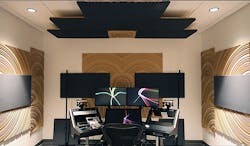ACOUSTICS 101 SERIES: Part 1 / Part 2 / Part 3 / Part 4 / Part 5 / Part 6 / Part 7
The world is louder and brighter than ever before. Speakers and lights emanate from every person’s cell phone and every storefront on every street corner. Concerts are louder than airplanes and Times Square is literally as bright as the sun, day or night. How do we adapt to this ever-growing age of electronics and its corresponding auditory overload?
In this new 12-part series on acoustics, we will discuss how to design for an increasingly louder world. We’ll cover acoustic theory (traditional to quantum) and the latest in building science technologies. As a brief primer, let’s discuss the most salient questions that affect everyone: What is acoustics and why does it matter?
What is acoustics?
Acoustics is the science of sound. On an everyday level, it is the field of study that deals with sound and vibration, from creation to control. On a more complex level, it’s a subdivision of physics, focusing on the wave behavior of sound energy: propagation, control, materials, and more recently, quantum mechanical behavior. Acoustics as a business can involve consulting to solve a specific goal, design to create a specific architectural environment or product, and testing to measure and collect scientific data on anything acoustically relevant.
In the world of architecture and interiors, the typical situation most designers face on a daily basis involves what is known as electro-acoustics and room acoustics. Electro-acoustics is a specific subset of the field wherein a large percentage of the sound energy is created by electronic transducers (loudspeakers).
Room acoustics is another division of acoustics, focused primarily on the behavior of sound within interior spaces versus underwater, outdoors, or underground areas. The combination of electro-acoustics and room acoustics encompasses most everything architecture and interiors deal with: home theatre, audio production suites, conference rooms, offices, transportation, movie theatres, and any interior space where people and electronics exist together.
Why does acoustics matter?
As a visually dominant species with an obsession for electronic devices, humans tend to overlook acoustics in our daily lives. Notable cases are large office spaces populated by cubicles, unintelligible schoolrooms, and concerts exceeding the volume of a jet airplane.
Like many sciences, acoustics has great potential to affect people in many positive and negative ways. Everyone has danced to music expressing pure joy and emotion. Likewise, everyone has sat at a dinner table where they couldn’t understand anything the person next to them was saying.
The goal of a well-designed acoustical environment is to have people experience a great concert with phenomenal music or a meal with stimulating conversation in a beautiful space. Sadly, more often than not, people’s memories are of a loud, expensive concert that left their ears ringing or a dinner with unintelligible conversation despite the interesting people.
Acoustics is a unique combination of physics, thermodynamics, and material science. As the meaning of content is important to us as humans, intelligibility, cognition, and perception are critical elements when applying acoustics to architecture and interiors. Again, more often than not these elements are left unaddressed.
The purpose of this 12-part series is to share knowledge; to give architects and interior designers a basis of knowledge from which they can properly assess a project for the acoustical scope of work, budget, and impact. Important items an architect needs to know up front include when to bring the acoustician on board, how much work will it take, how much will it cost, how it impacts the project schedule and costs versus impact. These are exactly the same parameters as every other element of architecture.
In a perfect world, clients start with an acoustician first or hire the architect and acoustician at the same time. Alternatively, the worst possible situation is when an acoustic-centric project such as an audio production facility is initially underestimated, causing downstream issues in budget, timeframes, and ultimately acoustical performance.
Unfortunately, the field of acoustics is given very little attention in architecture schools, resulting in generations of architects forced to learn it on the job, costing clients time, money, and quality. Thankfully, a new awareness of acoustics in the public eye has created a need for greater education and effective solutions in the design and construction fields.
Next month we’ll start with the basics of acoustics, ranging from traditional classical mechanics to the latest in quantum acoustics. Along the way we’ll review widespread challenges, applied technology, products, and case study projects. Each month, you can find the latest in the series at interiorsandsources.com
ACOUSTICS 101 SERIES: Part 1 / Part 2 / Part 3 / Part 4 / Part 5 / Part 6 / Part 7
Hanson Hsu is the principal acoustician and founder of Delta H Design Inc. (DHDI), a research, design, and build firm providing design and consulting services for architecture and acoustics since 1998. Clients include Universal Music Group, Yahoo Music, Microsoft Studios, LinkedIn, Kanye West, U2, Cher, and more. DHDI specializes in facility design, studio design, transportation, products, and technology innovation using the revolutionary ZR Acoustics design paradigm based on Quantum Acoustics.
For more on Hanson Hsu and DHDI, please visit deltahdesign.com
